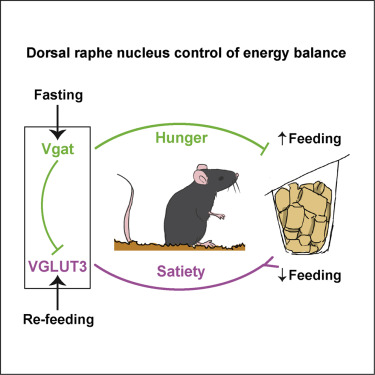![Brain mapping and molecular pharmacology approaches find specific neurons in the dorsal raphe nucleus as being essential regulators of feeding behavior. [Nectow et al., 2017, Cell 170, 429–442]](https://genengnews.com/wp-content/uploads/2018/08/Jul31_2017_Cell_CorsalRapheNucleus4011720886-1.jpg)
Brain mapping and molecular pharmacology approaches find specific neurons in the dorsal raphe nucleus as being essential regulators of feeding behavior. [Nectow et al., 2017, Cell 170, 429–442]
Researchers at The Rockefeller University report that two populations of cells in the brain may be responsible for regulating appetite. They published their findings (“Identification of a Brainstem Circuit Controlling Feeding”) in Cell.
The two types of cells, located in the dorsal raphe nucleus (DRN), are potential targets for new drugs to treat obesity by controlling the hunger signals that drive the search for and consumption of food.
“…we show that neurons in the dorsal raphe nucleus, expressing vesicular transporters for GABA [gamma-aminobutyric acid] or glutamate (hereafter, DRNVgat and DRNVGLUT3 neurons), are reciprocally activated by changes in energy balance and that modulating their activity has opposite effects on feeding—DRNVgat neurons increase, whereas DRNVGLUT3 neurons suppress, food intake,” write the investigators. “Furthermore, modulation of these neurons in obese (ob/ob) mice suppresses food intake and body weight and normalizes locomotor activity.
“Finally, using molecular profiling, we identify druggable targets in these neurons and show that local infusion of agonists for specific receptors on these neurons has potent effects on feeding. These data establish the DRN as an important node controlling energy balance.”
“Obesity is generally associated with leptin resistance,” says Jeffrey Friedman, M.D., Ph.D., Marilyn M. Simpson Professor and head of Rockefeller's laboratory of molecular genetics. “And our recent data suggest that modulation of the activity of specific neurons with drugs could bypass leptin resistance and provide a new means for reducing body weight.”
Alexander Nectow, who completed his Ph.D. in Dr. Friedman’s lab, and colleagues focused on the DRN when whole-brain imaging made with iDISCO, an advanced technique developed at Rockefeller, revealed that this part of the brain becomes activated in hungry mice. Subsequent imaging of other mice that were fed more than their normal amount of food, until they were full, revealed a different pattern of DRN activity.
These results indicated quite clearly that neurons in that part of the brain played a role in feeding behavior, say the scientists.
The next step, explains Dr. Nectow, now an associate research scholar at Princeton University, was to determine which of the several types of neurons that make up the DRN were involved. Genetic analysis of the activated cells in the two groups of mice showed that the neurons triggered by mice who had eaten released glutamate, a chemical that nerve cells use to signal one another, while the neurons triggered by hunger released a different neurotransmitter, known as GABA.
“There are two possibilities when you see something like that,” Dr. Nectow says. “One is that the cells are just along for the ride—they are getting activated by hunger but they're not actually driving the food intake process. The other possibility is that they are in fact part of the sense and respond mechanism to hunger—and in this case, we suspected the latter.”
The researchers turned on the glutamate-releasing cells in obese mice. This suppressed the animals' food intake and made them lose weight. And it confirmed that the DRN neurons turned on by hunger did indeed drive food intake.
Turning on the GABA-releasing neurons in the same part of the brain had the opposite effect and increased food intake. Notably, activating the “hunger neurons” automatically turned off the “satiety neurons,” maximizing the effect.
The researchers next looked at what would happen if they switched off hunger neurons in obese mice. “We were excited to see that prolonged inhibition of these neurons could dramatically reduce body weight,” says postdoctoral fellow Marc Schneeberger Pane, Ph.D.
The findings open up new avenues of research into exactly how the brain controls eating and suggest that drugs designed to activate or inhibit neurons in the DRN could be effective in treating obesity and preventing its related disorders, such as diabetes and hypertension.







